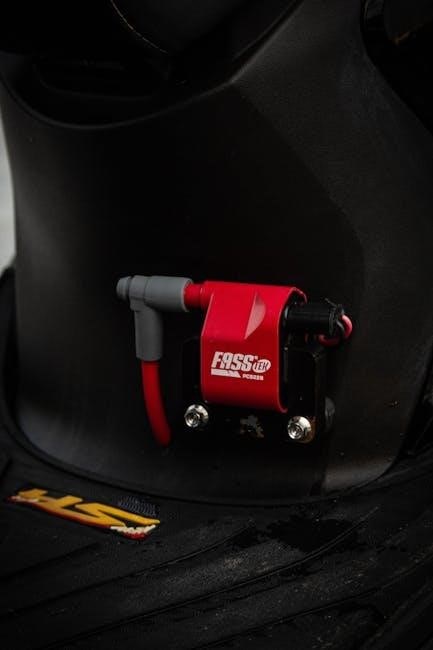
omni mount installation instructions
Welcome to the Omni Mount installation guide! This comprehensive resource provides step-by-step instructions for securely mounting your TV, ensuring a safe and efficient setup process for all users.
Overview of Omni Mount Installation
The Omni Mount installation process is designed to be straightforward and efficient, ensuring a secure and stable setup for your TV. The process involves attaching a mounting plate to the TV, installing a wall bracket, and then securing the TV to the bracket. Proper alignment and leveling are crucial to ensure optimal viewing and prevent damage. The installation requires basic tools and materials, such as Allen wrenches, screws, and wall anchors, which are typically provided in the hardware kit. Following the manufacturer’s guidelines and safety precautions is essential to avoid potential hazards and ensure a successful installation. With careful planning and execution, the Omni Mount system provides a reliable and adjustable solution for mounting your television.
Safety Precautions
Always handle heavy TVs with care to avoid injury. Be cautious of pinch points and ensure proper securing of cables. Use cable ties for a clean setup and verify stability before use.
Understanding Safety Guidelines
Understanding safety guidelines is crucial for a secure installation. Always read the manual thoroughly before starting. Ensure the TV and mount are compatible in weight and size. Use appropriate tools and avoid over-tightening, which can damage components. Be mindful of pinch points during assembly to prevent injury. Keep loose clothing and long hair tied back. If unsure about any step, consult a professional. Proper preparation and adherence to these guidelines will ensure a safe and successful installation process for your Omni Mount.
Identifying Potential Hazards
Identifying potential hazards is essential for a safe installation. Be aware of pinch points during assembly, as moving parts can cause injury. Ensure all cables are securely managed using zip ties or bundling to prevent damage or tripping. Verify the weight limit of your Omni Mount to avoid overloading, which could lead to equipment failure. Check the wall condition to ensure it can support the combined weight of the TV and mount. Improper installation or ignoring weight limits may result in damage or injury. Always follow the manufacturer’s guidelines and take necessary precautions to minimize risks during the installation process.

Tools and Materials Needed

Gather essential tools like Allen wrenches, screwdrivers, and a stud finder. Required materials include wall brackets, TV mounting plates, screws, and spacers for a secure setup.
Essential Tools for Installation
To ensure a smooth installation process, gather the following essential tools: an Allen wrench for adjusting bolts, a screwdriver for securing screws, and a stud finder to locate wall studs. Additionally, cable ties or zip ties are recommended for organizing cables neatly. A level tool is crucial for ensuring the mount is properly aligned and the TV is straight. Pencil and marker are needed for marking drill holes and alignment points. For heavier mounts, a drill with appropriate bits may be necessary to secure the wall bracket. Lastly, a torque wrench can be useful for applying the correct amount of force when tightening bolts. Having these tools ready will streamline the installation and prevent delays.
Required Materials and Hardware
The Omni Mount installation requires specific materials to ensure a secure and stable setup. Gather the wall brackets, TV mounting plate, and hardware kit provided with the Omni Mount. Additionally, you may need screws, spacers, and washers for fitting the mount to your TV. For wall installation, ensure you have wall anchors or screws suitable for your wall type (e.g., wood studs or concrete). Retaining pins and adjustment knobs are included for securing the TV and adjusting its position. Cable management supplies, like zip ties or clips, are optional but recommended for a clean setup. Make sure all components are compatible with your TV’s size and weight to ensure proper installation and safety.

Preparation Steps
Plan the installation layout, gather all tools and materials, and clear the workspace. Ensure the TV and wall are ready for mounting, following safety guidelines.
Understanding the Omni Mount Hardware
The Omni Mount hardware consists of a mounting plate, wall bracket, adjustable arms, and various screws and spacers. The mounting plate attaches directly to the TV, while the wall bracket secures to the wall. The arms provide flexibility for tilting and swiveling. Ensure all components are compatible with your TV size and weight. Familiarize yourself with the hardware kit, which includes bolts, washers, and spacers for a secure fit. Organize the parts before starting to avoid confusion. Refer to the manual for specific hardware allocations and torque specifications. Properly understanding each piece ensures a stable and functional installation.
Assessing Wall Types and Conditions
Before installation, evaluate your wall type and condition to ensure a secure setup. Common wall types include drywall, plaster, concrete, and wood studs. For heavy TVs, locating wall studs is crucial to prevent damage. Use a stud finder to identify the wooden beams behind the wall. Check for any cracks, holes, or weaknesses that could compromise stability. If installing on concrete, ensure the surface is level and free of debris. For drywall, use anchors to reinforce the screws. Properly assessing your wall ensures the mount stays secure and supports the TV’s weight safely. This step is vital for preventing future issues and ensuring optimal performance. Always follow the manufacturer’s recommendations for your specific wall type.
Installation Process
The installation involves attaching the mounting plate to the TV, securing the wall bracket, and adjusting the tilt and arm swing for optimal viewing. Follow the manufacturer’s instructions carefully to ensure a stable and secure setup.
Attaching the Mounting Plate to the TV
Begin by removing the TV’s factory-mounted stand or any existing brackets. Locate the mounting plate and align it with the VESA mounting holes on the back of the TV. Use the provided screws to secure the plate, ensuring they are tightened firmly but avoid overtightening. Double-check the alignment to ensure the plate is level and properly seated. If your TV has a curved back, consult the manual for specific instructions. Once the plate is securely attached, proceed to mount the wall bracket. Always refer to the Omni Mount manual for model-specific guidance to ensure a safe and stable installation.
Mounting the Wall Bracket

Locate the wall studs using a stud finder to ensure a secure installation. Drill pilot holes into the wall at the marked positions, then insert the wall anchors provided with the Omni Mount kit. Align the wall bracket with the pilot holes, ensuring it is level. Screw the bracket into place using the provided screws until it is firmly secured. If installing on a concrete wall, use the appropriate concrete anchors for added stability. Double-check the bracket’s level and tighten all screws to ensure a sturdy base for your TV. Refer to the Omni Mount manual for specific torque recommendations to avoid over-tightening. A secure wall bracket is essential for safely supporting the weight of your TV.
Securing the TV to the Wall Bracket
Carefully lift the TV and align the mounting plate on the back of the TV with the wall bracket. Ensure the TV is centered and properly aligned with the bracket. Gently lower the TV onto the wall bracket, making sure the mounting arms click securely into place. Tighten the locking screws on the wall bracket to hold the TV firmly in position. Use a level tool to double-check the TV’s alignment and adjust if necessary. Once secured, test the TV’s stability by gently rocking it back and forth to ensure it is firmly attached to the wall bracket. Properly securing the TV prevents any movement or shifting, ensuring a safe and stable installation.
Final Installation Checks

Once the TV is mounted, perform a thorough inspection to ensure everything is secure and properly aligned. Use a level tool to confirm the TV is straight and evenly positioned on the wall. Double-check that all screws and bolts are tightened firmly to prevent any movement or shifting. Test the TV’s stability by gently rocking it back and forth to ensure it is securely attached to the wall bracket. Verify that the tilt and swivel functions operate smoothly, with no obstructions. Finally, inspect all cables and connections to ensure they are properly secured and organized, using cable ties or zip ties if necessary. A final visual inspection will confirm that the installation is complete and meets safety standards.

Adjustments and Fine-Tuning
Adjust the tilt for optimal viewing angles, modify arm swing for smooth movement, and ensure the TV is level. Fine-tune friction knobs for stability and secure the setup.

Adjusting the Tilt for Optimal Viewing

To achieve the perfect viewing angle, tilt your TV to the desired position. Once satisfied, tighten the Tilt Adjustment Knob firmly to secure the TV in place. This adjustment helps minimize glare and ensures an optimal viewing experience. For best results, test the tilt by gently rocking the TV to confirm stability. Proper tilt adjustment enhances comfort and reduces eye strain during extended viewing sessions. Always ensure the TV is level after adjusting the tilt for a balanced display. This step is crucial for both functionality and visual appeal, making it a key part of the installation process.
Modifying Arm Swing and Friction
To modify the arm swing and friction, locate the pivot points on the mount. If the arms are too easy or difficult to move, adjust the friction by tightening or loosening the pivot screws using an Allen wrench. Proper friction ensures smooth movement and prevents excessive wear. For optimal performance, test the arm swing after adjustments to ensure it meets your preferences. Adjusting the friction correctly enhances the overall functionality of the mount, providing a seamless viewing experience. This step is essential for ensuring the TV mount operates smoothly and securely, catering to your specific needs for positioning and stability.
Leveling the TV for Proper Alignment
Proper alignment is crucial for both functionality and aesthetics. Use a spirit level to ensure the TV is perfectly horizontal and vertical. If the TV is slightly off, adjust the tilt adjustment knob to achieve the desired angle. For minor corrections, loosen the mounting brackets slightly and gently shift the TV into position. Once aligned, tighten all screws securely. Proper leveling prevents uneven viewing angles and ensures the TV remains stable. Regular checks are recommended to maintain alignment, especially after adjustments. A well-aligned TV enhances the overall viewing experience and prevents potential damage from improper positioning. Always refer to the Omni Mount manual for specific leveling instructions tailored to your model.

Troubleshooting Common Issues
Identify issues like loose parts or misalignment. Tighten hardware, adjust friction at pivot points, or use cable ties for a clean setup. Ensure stability and proper function.
Identifying and Resolving Common Problems
Common issues during Omni Mount installation include loose hardware, misalignment, or excessive friction. Start by ensuring all bolts and screws are tightened properly. If the TV is uneven, adjust the tilt knob or leveling mechanism. For friction issues, check the pivot points and tighten or loosen as needed. If the mount feels unstable, verify that the weight limit is not exceeded. Consult the manual for specific adjustments. Use cable ties to manage wires for a cleaner look. If problems persist, refer to the troubleshooting section or contact support. Properly addressing these issues ensures a secure and functional setup, enhancing your viewing experience. Always follow safety guidelines to avoid damage or injury.
Addressing Friction and Movement Issues
If the Omni Mount arms are too stiff or too loose, adjust the friction at the pivot points using a 10mm wrench. Ensure smooth movement by tightening or loosening the adjustment knobs as needed. Avoid over-tightening, as this may restrict the mount’s functionality. For optimal performance, test the arm swing and tilt after adjustments. If issues persist, consult the manual for specific guidance. Properly addressing friction and movement ensures a seamless viewing experience. Regular checks and minor adjustments can prevent future problems, keeping your setup stable and secure. Always follow the manufacturer’s recommendations for maintaining smooth operation and longevity of the mount.
Maintenance and Upkeep
Regular maintenance ensures the Omni Mount’s longevity. Clean the mount with a soft cloth and mild detergent. Inspect for loose screws or damaged parts. Lubricate moving parts if needed. Refer to the manual for detailed care.
Cleaning and Inspecting the Mount
Regular cleaning and inspection are crucial for maintaining the Omni Mount’s functionality. Use a soft, dry cloth to wipe down the mount, removing dust and debris. For tougher stains, a mild detergent diluted in water can be applied, but avoid harsh chemicals. Inspect all moving parts, such as pivot points and joints, for signs of wear or damage. Check for loose screws or bolts and tighten them as needed. Lubricate any friction points with a silicone-based spray to ensure smooth operation. Refer to the manual for specific cleaning recommendations. Regular maintenance prevents corrosion and ensures the mount remains stable and secure over time.
Regular Checks for Stability
Regular checks for stability ensure your Omni Mount remains secure and functional. Start by verifying that all screws and bolts are tightly fastened, especially around the wall bracket and TV plate. Inspect the wall anchors to confirm they are firmly embedded and not loosening over time. Check the weight limit to ensure your TV does not exceed the mount’s capacity. Gently rock the TV back and forth to test for any movement or wobbling. If instability is detected, tighten the relevant hardware or consult a professional for assistance. These routine checks help prevent accidents and maintain the integrity of your installation over time.
Congratulations! You’ve successfully installed your Omni Mount. Enjoy your perfectly positioned TV with effortless adjustments. Refer to this guide for future tweaks and maintenance tips.
Final Thoughts and Tips
Installing an Omni Mount is a straightforward process when following the provided instructions. Always ensure the mount is level and securely fastened to avoid instability. Adjust the tilt and arm swing to your preferred viewing angle, and use cable ties for a neat setup. Regularly inspect the mount for wear and tear to maintain stability. For optimal performance, refer to the manual for specific model adjustments. If issues arise, consult troubleshooting guides or contact support. Proper maintenance ensures long-lasting reliability and safety. Enjoy your perfectly mounted TV with enhanced viewing experiences!

40 days fasting and prayer guide pdf

omar khayyam poems pdf
You May Also Like

asme boiler and pressure vessel code pdf free download
November 26, 2024
the glass castle pdf
October 7, 2025